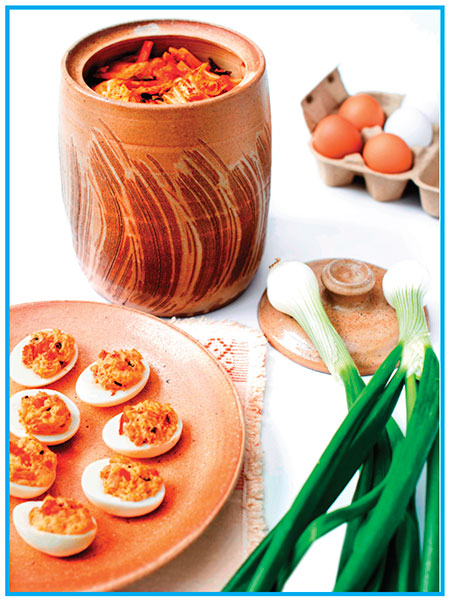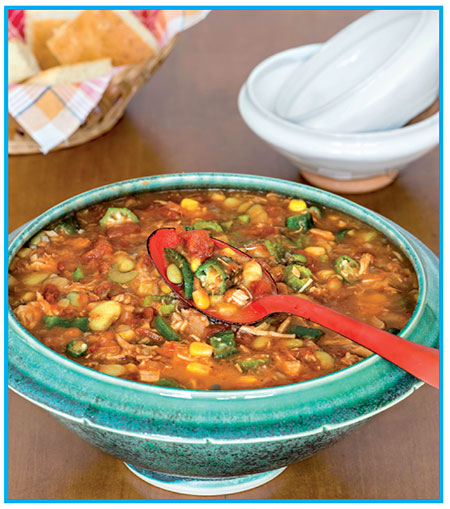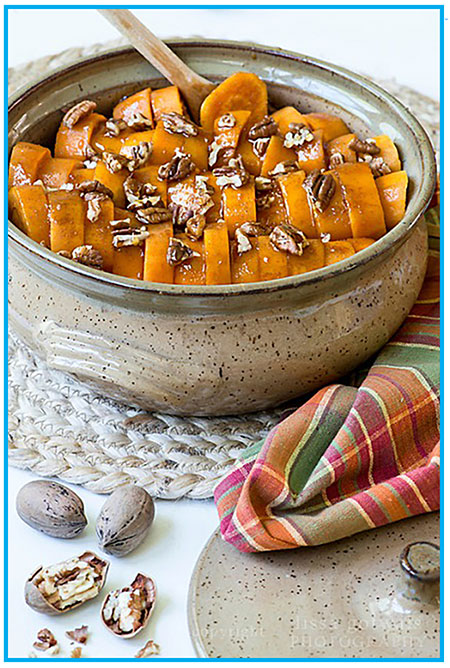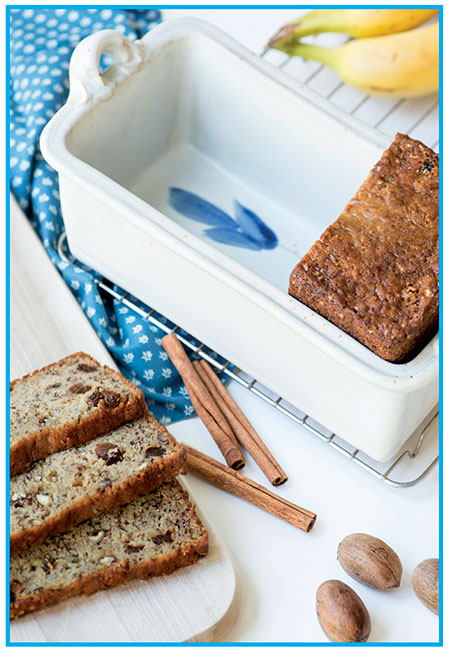
After working in New York City publishing, Jean Anderson – a member of the James Beard Cookbook Hall of Fame and author of more than a dozen cookbooks – returned to Chapel Hill, bought an old house and filled it with cookbooks and pottery.
"Kiln to Kitchen: Favorite Recipes From Beloved North Carolina Potters," Anderson's newest work, combines her love of food and the earthenware in which it goes. After all, functional pieces – pie plates, casseroles, jugs and mugs used for food and drink – are what made North Carolina pottery famous.
In the book, following an introduction to our state's ceramics traditions and instructions for cooking in clay, Anderson sets off on tours that wind through our pottery regions. She profiles potters and shares their favorite recipes.
Here are dishes that will hit the spot for the holidays.
Kimchi Deviled Eggs
From Julie Jones of Julie Jones Pottery, Durham
Makes 6 servings
 "My husband, Steven, has an adventurous palate," Julie Jones says, "and started making kimchi deviled eggs whenever we needed to take an appetizer to share at gatherings. They disappear rapidly because they're both exotic and delicious."
"My husband, Steven, has an adventurous palate," Julie Jones says, "and started making kimchi deviled eggs whenever we needed to take an appetizer to share at gatherings. They disappear rapidly because they're both exotic and delicious."
Eggs
1 dozen large hard-cooked eggs, shelled
1/4 cup finely chopped kimchi
3 tablespoons mayonnaise (see Tip)
1/2 tablespoon kimchi liquid
1 tablespoon gochujang (see Note)
1/2 teaspoon Asian toasted sesame oil
1/2 teaspoon rice vinegar
1/4 teaspoon salt, or to taste
1/4 teaspoon freshly ground black pepper, or to taste
Garnish
1 medium-size scallion, trimmed and thinly sliced (include green tops), and if you like, cut a second medium-size scallion into thin sticks to cluster on the deviled egg platter
1/4 teaspoon black sesame seeds
1. Halve the hard-cooked eggs lengthwise, pop the yolks into a medium-size nonreactive bowl and mash well with a fork. Arrange the whites on a large rimmed baking sheet lined with several thicknesses of damp paper toweling and set aside.
2. Add all the remaining ingredients (kimchi through black pepper) to the mashed yolks and mix thoroughly.
3. Spoon the yolk mixture into the egg whites, dividing as evenly as possible. Or if you want to get fancy, pipe the yolk mixture through a pastry bag fitted with a plain or fluted No. 10 nozzle, swirling it into a decorative pattern.
4. Cover the pan of deviled eggs and refrigerate overnight or until ready to serve the next day.
5. Just before serving, garnish the deviled eggs with sprinklings of thinly sliced scallion and a light scattering of black sesame seeds. Arrange on a large pottery platter (Julie uses one of her own), then if you like, cluster thin scallion sticks in the center of the platter.
Tip: For a creamier filling, add 1 more teaspoon mayonnaise.
Note: Gochujang is a pungent fermented hot red pepper paste or sauce. Look for it at Asian or specialty groceries (or order it online). In a pinch, substitute sriracha sauce.
Lucille's Brunswick Stew
From Ben Owen III, Ben Owen Pottery, Seagrove, N.C.
Makes 8 to 10 servings
 Ben Owen says that on the coldest winter evenings, his grandfather, the Jugtown master potter for whom he is named, "could smell the aroma of this stew floating out to the potter's wheel. His wife, Lucille, never had to call him – he just knew when the stew was ready." Also that it would be accompanied by "a big black skillet of hot cornbread."
Ben Owen says that on the coldest winter evenings, his grandfather, the Jugtown master potter for whom he is named, "could smell the aroma of this stew floating out to the potter's wheel. His wife, Lucille, never had to call him – he just knew when the stew was ready." Also that it would be accompanied by "a big black skillet of hot cornbread."
1 (4-pound) oven-ready chicken (see Notes)
Chicken giblets, if any, well rinsed
1 quart water (about)
2 teaspoons salt, or to taste
1 small chili pequin (dried hot pepper pod)
1 large clove garlic, smashed and skin removed
2 medium-size celery ribs, trimmed and sliced about 1-inch thick
1 medium-size green bell pepper, cored, seeded, quartered, and each quarter thickly sliced
2 large bay leaves, crumbled
2 cups shelled lima beans (see Notes)
2 cups whole-kernel corn (see Notes)
2 cups thickly sliced, stemmed small okra (see Notes)
1 quart tomatoes, preferably home-canned
1/2 teaspoon freshly ground black pepper, or to taste
1. Place the chicken, giblets (if any), water, salt, chili pequin, garlic, celery, bell pepper and bay leaves in a deep, heavy nonreactive 3-1/2- to 4-quart soup pot, set over moderately high heat, and bring to a simmer.
2. Adjust the heat so the water barely ripples, cover and simmer for about 1 hour or until the chicken is fork-tender.
3. Lift the chicken to a large cutting board, then strain the cooking liquid into a large fine sieve set over a medium-size bowl. Discard the solids in the sieve.
4. Return the strained broth to the soup pot, add all the remaining ingredients, cover and bring to a simmer.
5. Meanwhile, when the chicken is cool enough to handle, tear the meat from the bones in bite-size pieces and return to the pot.
6. Cover and continue simmering for 30 to 40 minutes or until the flavors meld. (If at any point the stew seems too thick, add another cup of water or enough to thin the stew to the consistency of chowder.) When the stew is done, taste for salt and pepper and adjust as needed.
7. To serve, ladle the steaming stew into heated pottery soup bowls and accompany with fresh-baked cornbread.
Notes: Frozen limas, frozen whole-kernel corn, and frozen sliced okra can be substituted for the fresh. So, too, home canned. Some chickens have giblets, some don't. No problem. Stew's delicious with or without.
Mama's Sweet Potatoes
From Linda Hilton Long of B.R. Hilton Pottery, Newton, N.C.
Makes 6 to 8 servings
 "My mother always made this dish for holiday family gatherings," says Linda Hilton Long. "It's quick, easy, and nutritious!"
"My mother always made this dish for holiday family gatherings," says Linda Hilton Long. "It's quick, easy, and nutritious!"
She adds that her mother would buy sweet potatoes when they were on sale, cook up a batch, then peel and freeze them so that she could make this family favorite quickly.
What's unusual about the recipe is that the potatoes are partially cooked, then peeled, cut into medallions, stood on end, and baked in one of the Hilton casseroles.
6 large sweet potatoes of uniform size and shape, scrubbed but not peeled (see Tip)
1/4 cup (1/2 stick) butter
3/4 cup firmly packed dark brown sugar
3/4 cup fresh orange juice
1 tablespoon medium-brown unsulfured molasses
1/2 teaspoon ground cinnamon
1/4 teaspoon salt
1 teaspoon vanilla extract
1 cup coarsely chopped pecans (optional)
1. Parboil the sweet potatoes in enough water to cover in a large, heavy pot for 20 to 25 minutes or until not quite tender. Drain well, then slip into a large plastic zipper bag and refrigerate for at least ½ hour.
2. Meanwhile, spritz a 2-1/2 quart ovenproof stoneware, other pottery, ceramic or heat-resistant casserole with nonstick cooking spray and set aside.
3. When ready to proceed, melt the butter in a small nonreactive pan over low heat, then mix in the brown sugar, orange juice, molasses, cinnamon and salt, and cook and stir about 4 minutes or just until the sugar is thoroughly dissolved. Remove from the heat, mix in the vanilla and set aside.
4. Meanwhile, peel the chilled sweet potatoes, and cut crosswise into slices about 1/2-inch thick.
5. Lay the sweet potato end slices flat in the bottom of the prepared casserole, arranging some pointy sides down, others cut-sides down so that they fit together smoothly without overlapping. Now stand the remaining slices on end and in rows on top of the bottom layer, each touching its neighbors so that none will topple. Finally, pour the reserved brown sugar sauce evenly over all.
6. Set the casserole on a rimmed baking sheet (to catch boilovers), then slide onto the middle shelf of a cold oven, and set the thermostat at 350 degrees.
7. Bake the sweet potatoes uncovered for 45 minutes, basting every 20 minutes with the sauce that bubbles up. (It's easier to distribute the sauce evenly if you use a turkey baster.)
8. Add the pecans, if you like, sprinkling evenly over the sweet potatoes, and bake 15 minutes longer or until the potatoes are fork-tender.
9. Serve at once as an accompaniment to roast turkey, chicken or pork. Delicious, too, with baked ham.
Tip: Choose sweet potatoes that are 2- to 2-1/2 inches in diameter. If you refrigerate the cooked, peeled sweet potatoes for about 30 minutes, they'll slice cleanly.
Banana-Nut Bread With Raisins
By Jon Ellenbogen of Baking Spider Pottery, Penland, N.C.
Makes one 9x5x3-inch loaf
 Jon Ellenbogen of Baking Spider Pottery likes to serve whipped cream cheese with this banana bread. It's inspired by a recipe in "Beard on Bread" (Random House, 1973), which Ellenbogen bakes in Barking Spider's stoneware loaf pan.
Jon Ellenbogen of Baking Spider Pottery likes to serve whipped cream cheese with this banana bread. It's inspired by a recipe in "Beard on Bread" (Random House, 1973), which Ellenbogen bakes in Barking Spider's stoneware loaf pan.
"The bread freezes well," he says, "and I usually have one in the freezer."
Note: Unlike mass-produced metal pans, pottery ones are individually shaped and thus their dimensions vary slightly from pan to pan, but fortunately not enough to affect baking times.
2 cups sifted all-purpose flour
1-1/2 teaspoons baking soda
1/2 teaspoon baking powder
1/2 teaspoon salt
3/4 cup granulated sugar
1/4 cup raw sugar
3/4 cup coarsely chopped pecans, walnuts or black walnuts
1/2 cup golden raisins or, if you prefer, seedless brown raisins
3 medium-size overripe bananas (about 1 pound), peeled and mashed
1/3 cup buttermilk (or more as needed)
1/3 cup melted unsalted butter
2 large eggs
1 tablespoon fresh lemon juice
1. Preheat the oven to 350 degrees. Stand a 9x5x3-inch ovenproof stoneware, other pottery, ceramic, or heat-resistant glass loaf pan on a small sheet of aluminum foil, and trace around the bottom of the pan. Using scissors, cut around the traced lines, then place the foil liner shiny-side down in the bottom of the pan. Now spray the foil and the sides of the pan liberally with nonstick cooking spray, and then set the pan aside.
2. Whisk the flour, baking soda, baking powder and salt together in a large bowl, add the granulated and raw sugars, and whisk well to combine. Mix in the pecans and raisins, then make a well in the middle of the dry ingredients and set aside.
3. Using a hand electric mixer at high speed, beat the remaining ingredients (mashed bananas through lemon juice) 1 to 2 minutes in a medium-size bowl until smooth.
4. Pour the liquid ingredients into the well in the dry ingredients and fold in – gently, gently. (If the batter is too stiff to pour, mix in another 2 to 3 tablespoons buttermilk.)
5. Scoop the batter into the prepared pan, smoothing the top and spreading to the corners.
6. Slide the pan onto the middle shelf of the preheated oven and bake for about 1 hour or until the bread begins to pull from the sides of the pan, is springy to the touch, and a cake tester inserted in the center of the loaf comes out clean.
7. Transfer the pan to a wire rack, setting right-side up, and cool the bread in the pan for 15 minutes.
8. Carefully run a small, thin-blade spatula around the edge of the bread to loosen it, invert on the wire rack and quickly peel off the foil liner. Turn the loaf right side up – easy does it – and cool to room temperature before cutting.
9. To serve, cut the banana bread into slices about 1/2-inch thick using your sharpest serrated knife. And don't forget to follow Jon's lead by putting out a bowl of whipped cream cheese.
All recipes from "Kiln to Kitchen: Favorite Recipes from Beloved North Carolina Potters" by Jean Anderson. Copyright © 2019 by Jean Anderson. Photographs by Lissa Gotwals. Used by permission of the University of North Carolina Press. www.uncpress.org